3 Ways To Blend Cultures Without Losing Your Identity

"We don't need a melting pot in this country, folks. We need a salad bowl. In a salad bowl, you put in the different things. You want the vegetables- the lettuce, the cucumbers, the onions, the green peppers- to maintain their identity. You appreciate differences."
- Jane Elliot
Let's Throw Out The Melting Pot!
I love this quote. I've always heard of America as a melting pot of different cultures. As a child, I didn't think twice about it because it made sense. Now that I hear it as an adult, it doesn't sit well with me.A melting pot means we all melt together and conform to the same thing. If America is a melting pot, then we're expected to keep the parts of our cultures that everyone is comfortable with and let the other things go.It brings me back to a question I get asked by many of you.
Now that I'm in an interracial relationship, do I have to lose my culture and conform to theirs?
No. Simply no.When your partner fell for you it was because of who you are, not what someone wanted you to be. Your culture and life has helped you to become the person you are today.As we begin blending cultures, some people go back to the melting pot idea. They think you have to melt all of your culture, traditions, and life together with your partners until it becomes something brand new. In reality, one of my favorite things about a multiracial family is that you're bringing together two distinct cultures.Over the last seven years, my husband and I have found ways to bring in traditions we both grew up with, parenting styles we had, and new customs unique to our own little family.When we first got together, there was a part of me that assumed I was expected to let go of my own culture. Some of it was my own idea of what I was supposed to do and some of it was expectations from other people.It took me a while to realize I had to put the melting pot aside because it wasn't working for my relationship or family. My husband was actually the big reason for this. He had been telling me from the beginning I wasn't expected to do anything I didn't want to do. If other people wanted those things, it was up to me to decide what I was comfortable with.As many of you know, culture expectations can be a heavy burden, but at the end of the day it's our choice. We can choose to conform to different expectations or we can find a different way.Our identity is made up of more than just our traditions. Our identity is who we are at the end of the day. As you're sitting here reading this, think about what's made you who you are today.You are who you are because of the decisions you've made, how you grew up, the influences you've had in your life, your culture, and so much more. Our identity truly does change over time.The identity I had before kids compared to now is different and I don't see it as a bad thing. It's because the love you have for your children changes you.As you get into a relationship, your identity changes because you start to care about someone and make room in your life for them. As you blend cultures, the same thing will happen, but it doesn't mean you have to lose your identity. You will develop a passion for this new culture and you'll notice you want to bring it into your life and family.If we can throw away the melting pot, the fear of losing ourselves to this new culture goes away. Our little salad bowl will contain the best parts of both of our cultures.
What can you do to make sure your relationship is a blend of two cultures?
Communicate
I can't ever say this one enough. Communication is so important. You need to talk to each other and let your partner know how you feel. They can't read your mind and if you don't speak up, nothing will change.
Check in with each other
Sit down with each other and discuss your relationship. Obviously, this will probably happen throughout the week as well, but make sure you're intentional about it at least once a month.Then you create a safe time to discuss how you're feeling. Whether this is how their family treats your traditions, how you feel blending cultures is going in your relationship, etc.Things change. An area of your relationship can be going great one month and struggle the next. Make sure you are always reevaluating together.
Make a list
I know this one might sound silly, but it's not. Make a list of things that are important in both of your cultures. Then you can think about how to make those things present in your lives.We currently don't live by my husband's family. Our kids don't get to see all of the Indian customs and traditions on a daily basis. Knowing what my husband wants his kids to know and follow based on his culture helps us find ways to intentionally incorporate it into our daily lives.Blending cultures is beautiful because it's bringing two people together and finding the best of both.
How do you make sure your family is a good blend of you and your partner's cultures?
Can I Get An Interpreter Over Here?
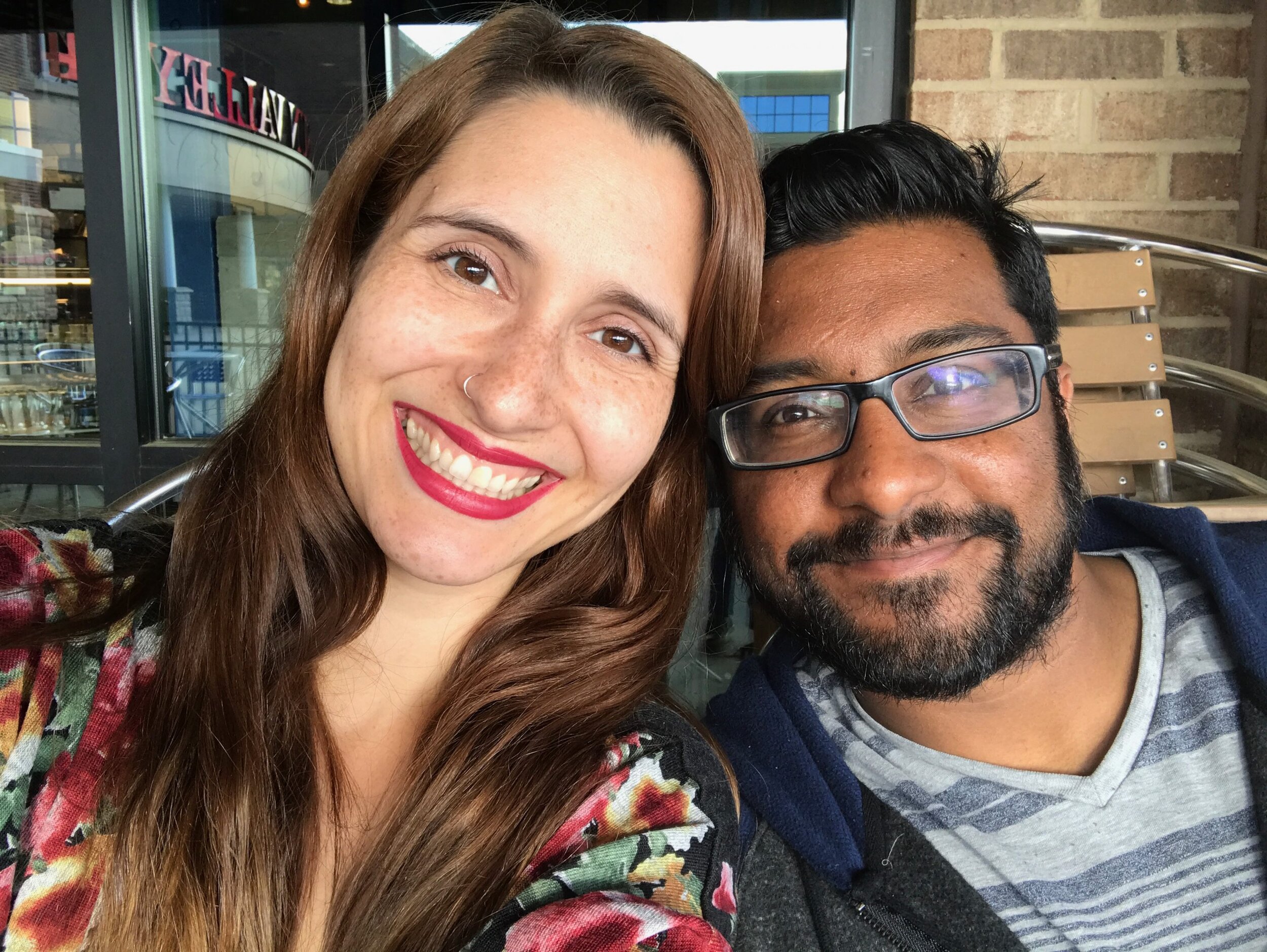 When my husband and I first met, we were doing an internship with our church. It was an amazing experience because we learned so much about ourselves during the program and of course met each other.The first time my husband saw me, I was interpreting for one of our morning classes. I had learned sign language the year before and helped out when I could by interpreting classes for my friends in the program.Learning sign language was amazing. It wasn't just the language I had learned that year, but I was introduced to deaf culture as well. I learned about deaf etiquette, how to interact with the deaf community, and how to blend cultures when the deaf and hearing community were together.
When my husband and I first met, we were doing an internship with our church. It was an amazing experience because we learned so much about ourselves during the program and of course met each other.The first time my husband saw me, I was interpreting for one of our morning classes. I had learned sign language the year before and helped out when I could by interpreting classes for my friends in the program.Learning sign language was amazing. It wasn't just the language I had learned that year, but I was introduced to deaf culture as well. I learned about deaf etiquette, how to interact with the deaf community, and how to blend cultures when the deaf and hearing community were together.
While I didn't know it at the time, I was preparing for a life of blending cultures for my multiracial family.
There were times throughout my internship where I would be sitting with my friends and signing for hours. If it was just my friend and I, hours would go by without me using my voice once. There wasn't any need to use my voice as long as I was mouthing the words. I was fully submerged into my conversation and didn't think twice about talking out loud.If someone that didn't understand sign would walk into the room, I immediately started voicing our conversation. I'll be honest, it took a lot of reminding because I assumed people around me understood. It became a routine that year for my deaf friends and I. I usually didn't mind, but there were times I just wished everyone knew the language. It took a lot of effort for my deaf friend who wanted to speak to everyone and I wished it could be easier for her.
Just about a year later, I was on the other side of the table.
My husband and I were getting married and we flew to Chicago. We decided to get married by his family so we could truly have a blended wedding and be able to incorporate both cultures.I'll never forget the first few times I would sit at a table without understanding a word that was spoken in front of me. My husband did his best to interpret, but he was just learning like I had the year before. It wasn't natural to him yet, so I often had to nudge his arm and ask what people were saying.I finally understood how frustrating it is to have people have a full conversation in front of you without being included. Honestly, it was painful. I felt like I was back in middle school, being left out from the group.
While I know now it's rarely intended that way, it's still uncomfortable.
You start making up conversations in your head, trying to guess what they're talking about. It makes it so much worse if you don't get along with your inlaws. Then you pick up on the few words you do know like "thella pilla" which means white girl.During my wedding, it was the first phrase I learned. I was joking with my husband and his cousins. I was laughing saying I bet everyone is talking about me and all of the things I'm doing wrong. They laughed and let me in on a little secret.Don't worry, you'll know when they're talking about you. They'll look straight at you and you'll hear "thella pilla."
A crash course into the Indian community!
I'm almost 8 years into my interracial marriage and I still encounter those uncomfortable moments. I don't know the language like I wish I did. I know bits and pieces so my imagination runs away before I can stop it.Most of those experiences have been because family is together and it feels comfortable for them to speak in Telugu. They grew up speaking it and I can only imagine it feels like home when they gather around the table telling jokes in Telugu. Those are the moments I ask my husband to interpret because I want to be a part of the group.Then there are the moments where people purposely speak another language in front of you so you don't understand. I still ask my husband to interpret, even if I can see the body language in the room is saying I probably don't want to know what's being said.
At the end of the day, if I truly want to be included in all of those conversations I have to learn the language.
I can't expect them to not speak Telugu in front of me, just like I wouldn't expect my deaf friends to stop signing.It's their language and no one can ask them to stop speaking it. I can, however, ask for my husband to be my built-in interpreter. sometimes it serves as a reminder for people to use English more so my husband doesn't have to. Or they start interpreting for me as well as teaching me what little words mean.
Have you ever been the only one at the table who doesn't know the language? What did you do?
Multiracial Motherhood: Our Multiracial Family Through Adoption

What We Can Learn From One Mother's Story
Happy Friday! I thought we could kick off the weekend by starting up one of my favorite series again!Family Fridays!This series is so special to my heart because it's a chance for mothers to come together and share their experiences with their own multiracial family. The beautiful thing is that all of our families are unique. They all have their own special qualities, unique challenges, and different experiences.Today, my lovely and gorgeous friend Sara is sharing about her mixed race family. They have taught my family and I so much about diligence because Sara goes out of her way to make sure their lives reflect a true multiracial community. Check out more about her story below!
Let's Meet Sara
Hello, everyone! I'm Sara and I am excited to be here at The Almost Indian Wife to share a little bit about my family with you! Our situation is a bit different than the ones you may be used to reading about here, in that our family's multiracial "status" did not come about because of my husband or myself, but because of our children. And before I dive in, can I confess something? I don't always feel like we really are multicultural. Do we want to be? Yes! Are we working toward it? Yes! Do we still have lots more to learn? GOOD GRIEF, YES. And that's why I think connecting with other multi-cultural families is such a cool thing! Okay, back to the introductions...My husband, Phil, and I have been married for almost nine years now and we have two children. We lived in Ohio up until the spring of 2016 when we moved to Illinois. Phil and I were foster parents for four years in Ohio, during which we met and then adopted both our daughter and son. Russell (5 years) is African American and Claire (4.5 years) is Caucasian. Our children are not related biologically (yes, some people ask!) and have very different birth stories and foster care experiences. 
One thing my children do have in common though, (among plenty of other things, trust me) is that they have two parents who acknowledge and celebrate the things that make each of them unique.
Speaking of unique, let's talk culture. What exactly is culture anyway? Here's one definition: "The customary beliefs, social forms, material traits of a racial, religious, or social group;" also, "the characteristic features of every day existence shared by people in a place or time." Reading those definitions reinforces a couple things to me. One: The racial majority in our family is white American. That seemed so silly to even type but there it is. And let's be real, white American culture is not one we have to make an effort to call attention to. Ya know?
Two: If we want to be truly multi-cultural -- embracing, celebrating and participating in our son's racial culture -- we have to be intentional.
Neither my husband nor I are African American. And although our son is, he's been with us since he was two months old. Our white American culture is pretty much all he knows. So we have some work to do! What does this intentionality look like for us? Well, for starters, whenever I have the choice I choose African American. That might sound funny or off-putting but hear me out. It's not that we don't welcome and seek out other cultures. We absolutely do! But I'm here today talking specifically about my African American son and HIS culture and our desire for him to have racial mirrors in his life. If we want to raise a young man who embraces and is secure in his African American identity, he specifically needs African American people in his life. Okay, here's what I mean...Our community here in Illinois has a kids' sports program. So does the neighboring community. We're choosing to drive just a couple extra minutes to the neighboring community because it's more diverse. We figured there's a greater chance there for our son to have teammates and opponents and coaches who look like him than if he were playing on a sports team here. (Why didn't we choose to live there instead when we moved from Ohio, you ask? We wonder the same thing some times. Anyway...)When looking for a church to join, diversity was a priority for us. After Biblical teaching and gospel-centeredness, we looked for a place where our son could walk in and see people who looked like him. And not just in the pews, but on the stage speaking. In the classrooms teaching. In the small groups leading. When selecting books and toys for my kids, it's not difficult to find white baby dolls and white story characters and white action figures. In fact, if you're not purposely trying to avoid a whitewashed book and toy collection, you'll most likely end up with one. So when strolling through the store we see a giant Finn action figure (Star Wars main character who is African American- woo hoo!!), I snatch it up. A black baby doll for Claire? Yes, please. A picture book with black main characters instead of white ones? You get the idea. Now you might find this one silly, but I'm okay with that. When checking out at a store and I have the option (if it's not an insanely packed lane versus a totally empty one) I will choose a lane with a non-white cashier. 
We take our son to a black barber.
(A no-brainer.) This choice doesn't mean just one more racial mirror for my son. Every barber and almost every client there is African American. So, it means many. It means my son gets to be the majority. And my daughter and husband and I experience what it's like to be the minority. It means sitting and talking with people who share my son's culture. People who will tease me for never having seen "The Jeffersons" and who graciously and honestly answer my hair care questions. I'm telling you, walking into that shop where we are greeted by a packed room of 100% brown and black faces makes my heart swell with joy. Because the more we can immerse ourselves in African American culture, the more our family moves toward being truly multi-cultural. One more piece of advice. More important than all the little examples I shared above!
When seeking to embrace a culture that is not your own you have to first humbly acknowledge that you are not an expert.
And then start sharing your life with those who are! Become friends with people who are a part of your loved one's culture. Spend time with those who can help you understand the things you don't and who will lovingly correct you when you need it. I mean, read all the history you want; build the most diverse picture book library on planet earth; learn all the cultural traditions you can...but without real relationships with real people who know this culture, you will be missing out. And there you have it. We are a multi-racial family doing our best to recognize, embrace and encourage the unique identities of the precious children we've been entrusted with. We definitely don't have it all figured out but we're taking it one day at a time and learning as we go!
Follow Sara along on her journey and head over to her Instagram!
What Your Biracial Child Brings To School For Lunch Reveals More Than You Think
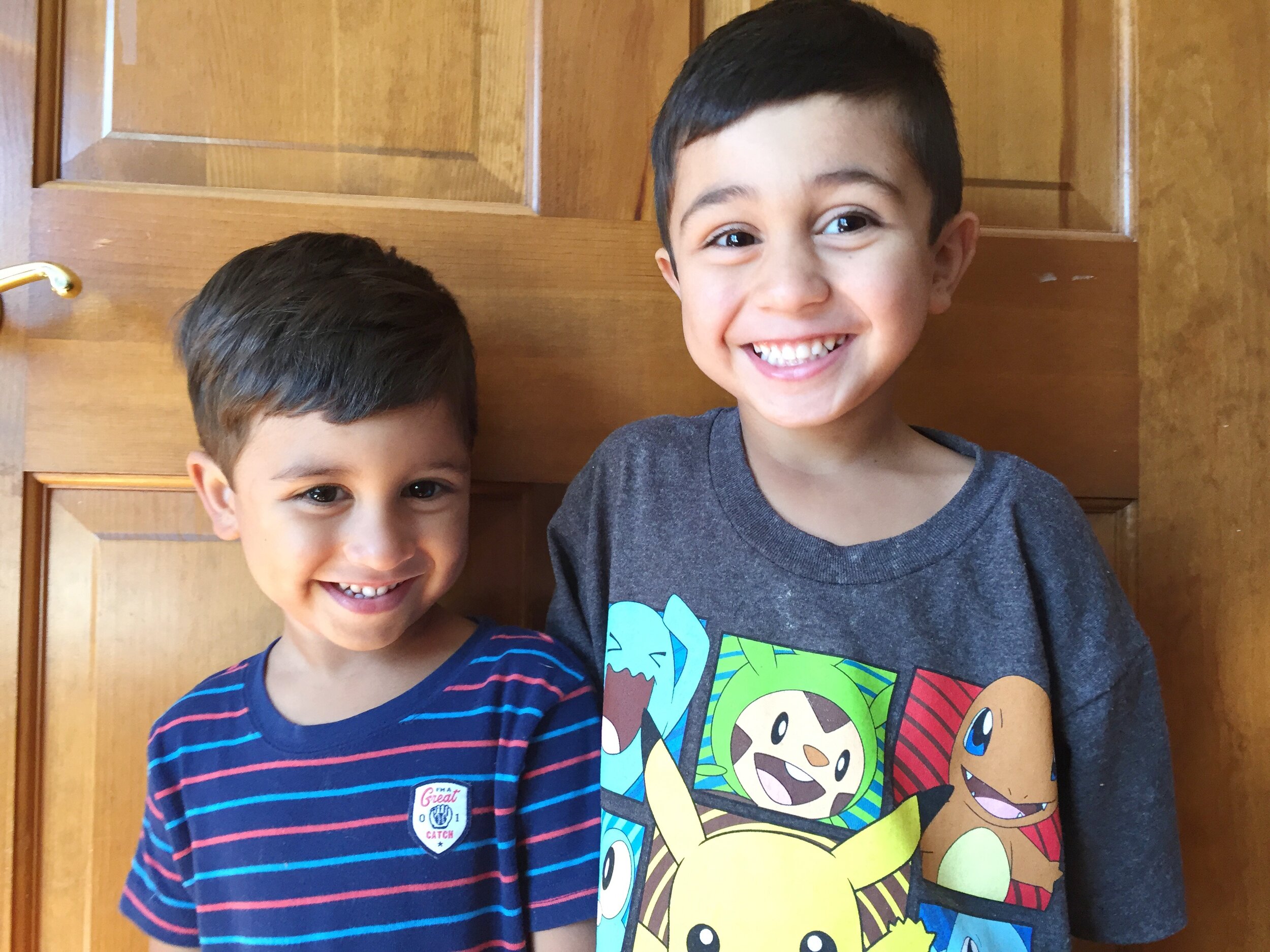
What Your Biracial Child Brings To School For Lunch Reveals More Than You Think
Over the last few years, my oldest son Liam has developed a huge love for leftovers. I don't know what it is, but every day around lunch time he asks what left overs we have. If by some chance we're out, he begs me to make leftovers...He doesn't just want a quick sandwich, he wants good food. He wants me to list out all the leftover options and gets excited to choose. I guess it's kind of like an international buffet at our house. We usually have pasta or Indian food like chicken curry. He's so obsessed with left overs that he started asking if he could bring left overs to school while we were visiting his cousins.Mom, will you send me left overs when I go to first grade next year?Now, his cousins are half Indian just like my kids are. They understand the multiracial dynamic because they're living it too! They're currently in elementary school and have plenty of thoughts on bringing left overs to school!
Their cousins are very comfortable in their biracial identity.
They've been to India, understand some Telugu, wear Indian clothes to events, and so on. They're also blessed with a momma that makes Indian food constantly and a daddy who makes comfort American food.I guess I assumed they'd want to bring their favorite dishes to school with them, but when I started asking them their answers surprised me.One of them told me they bring Indian food to school every single day. I wasn't surprised about this one because I've seen her devour a plate of tandoori chicken and I know how much she likes it.However, the other two said they won't bring Indian food to school and went on to tell me what their classmates have said about it in the past. Indian food has a distinct smell and their friends made fun of it. They hysterically laughed asking how they could eat that stuff.They only endured their friends bullying one time and decided then and there that they wouldn't bring Indian food to school anymore. Now, these kids love Indian food, but it wasn't worth being made fun of.
You guys, kids can be mean.
It broke my heart that they don't bring Indian food to school because of what people may say.I looked to their sibling and asked why she doesn't let her friend's bullying stop her from bringing Indian food to school. Her response was beautiful.I don't care what they say. At least I eat my favorite food every day.Boom! She hardly flinched when she said that and it's stuck with me since. I want my boys to have the same approach.As biracial kids, it's hard to be set apart. While most kids bring a PBJ to school, some kids bring traditional Indian left overs. There's nothing wrong with that! They bring what they would normally eat at home and it should be enough.It breaks my heart that kids bully each other over things they just don't understand. They look at an international dish and assume it's gross because they're not used to it.I hope and pray my kids won't let their friends determine what they bring to school for lunch.
I hope their pride and confidence in who they are helps them shrug off friend's comments.
This is why it's so important to me to have people over for Indian food and to eat with our hands. It shows our kids we won't grab a utensil just because our own friends may say something. Traditionally, you eat Indian food with your right hand in India and we do the same thing in out family.We also offer our kids and their friend's Indian treats during the day. Then we're right there if their friends say something and can gently encourage our kids to explain what it is and offer their friends some.Growing up a biracial child can bring about some unique challenges, but as a parent, I hope I can help them to build a strong identity that isn't rocked by what other people ignorantly say.
Have your kids every experienced this? If so what did you do?
If you like this, then check out this post!
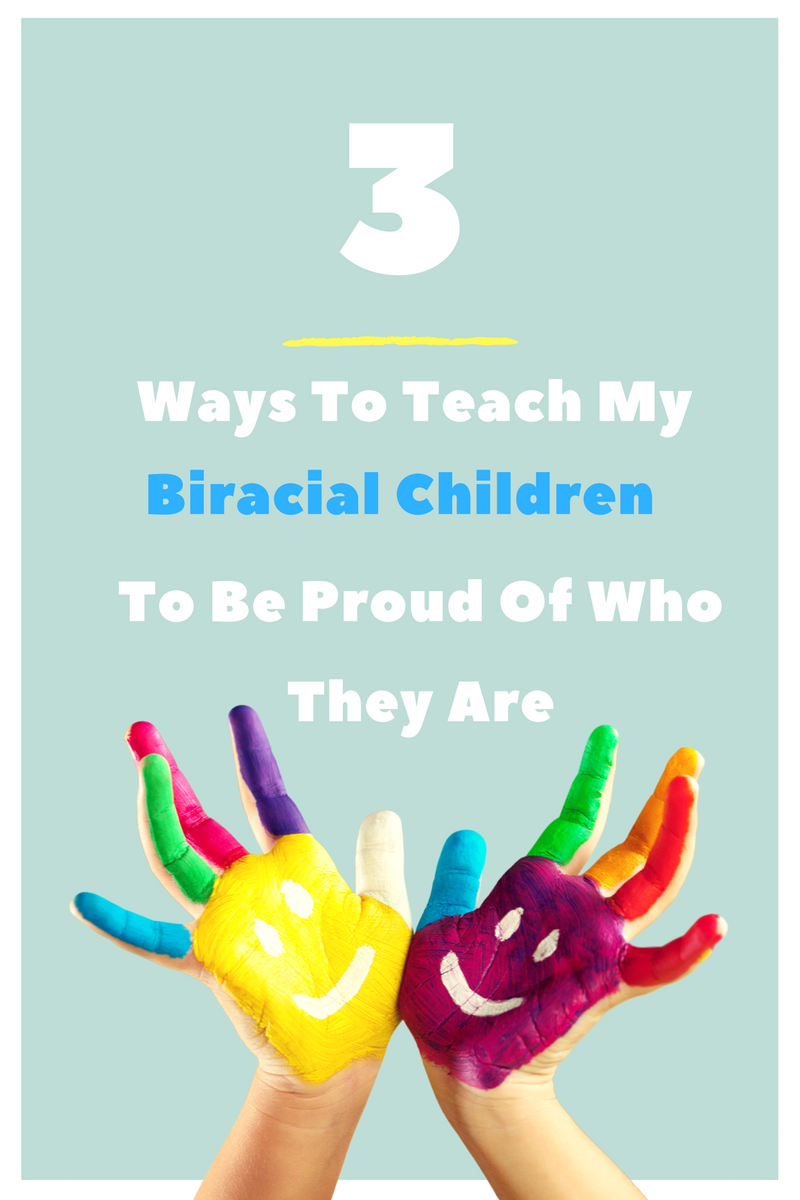
Celebrating Holi By Making It Colorful

This post is brought to you by Tea India. As always all opinions are my own.
How You Can Celebrate Holi
As spring is approaching, many Indian families around the world are getting excited. It means it's almost time for Holi, the Festival of Colors! This holiday has been making its way to the US as some colleges are even starting to celebrate it on their own!It's an opportunity for people to put down their differences and have some fun! During Holi week kids play pranks, colorful powder is thrown (or a color war if you're in our house!), and people are celebrating good over evil.As multicultural families, this holiday may look different to all of us. You may not know about the religious background to the holiday and that's ok. This is a great opportunity to teach your family about the world around them.As parents, we're raising global citizens. We have the opportunity to challenge hate and racism in the world by informing our kids. We can teach our kids about different holidays, customs, and ways of life. Holi is the perfect holiday to teach your kids about!It's all about love and celebration.

Colorful Activities
Another name for Holi is the Festival of Colors so as you can imagine, it's all about color! The time of year it's celebrated alone is all about flowers blooming and life starting fresh.There are so many ways you can teach your family about the Festival of Colors. Here are a few activities my kids love doing around this time of year.

Good Food
One of my family's traditions during Holi week is to prepare a delicious batch of Indian donuts. They're super fun and easy to make with the whole family! I swear my kids have a different sense just for Indian donuts because the second they smell them cooking they come running!


Celebrate Holi With Tea India
I've joined with Tea India today to see how we can help you #makeitcolorful! Whether this is your first time celebrating Holi or your family does every year, we want to see how you're celebrating!Be sure to share your traditions and don't forget to tag us!
Are you looking for a way to authentically experience Holi this year? Pick up Tea India's Chai moments! Their delicious, single serving drinks are the perfect way to experience Holi this year.I start most of my mornings off with a cup of their Chai Moments Milk Tea. They're so easy to make and even my husband loves how authentic every taste is!Learn more about Tea India's fresh and new products by following them today! You may even see us pop up on their feed!
How To Keep My Culture Alive While Living Abroad
 I'm very excited to join up with Lauren from English Wife Indian Life to share our stories. We're sharing how keep culture alive in our multicultural families. I share how we keep my husband's Indian culture alive in the US and she's sharing how she's keeping her English culture alive while living in India.
I'm very excited to join up with Lauren from English Wife Indian Life to share our stories. We're sharing how keep culture alive in our multicultural families. I share how we keep my husband's Indian culture alive in the US and she's sharing how she's keeping her English culture alive while living in India.
How To Keep My Culture Alive While Living Abroad
When I married an Indian, I remember thinking how lucky our children will be to belong to two extremely different cultures. As soon as I found out I was pregnant, I spent hours researching baby names that would fall easily from both tongues. Then I started to worry, my own cultural identity has been questioned numerous times, from “you should be more Indian now you live in India” to “it seems you are not proud to be British anymore”.Will my child have a similar experience? Will my child feel British at all growing up in India?India is the country I have called home for three years. Since leaving England to start a new life with the man I love, I have been learning about Indian values and traditions. In fact, I made it my mission to learn as much as I possibly could so I could understand my new family and the world around me. There are so many amazing things I want my son to learn and enjoy from Indian culture, but what about his other culture?I thought about the ways I have managed to maintain my culture in India, what parts are so important to me that I couldn’t leave them behind when I took off from Heathrow. I don’t want to force either culture down his throat, but I do want to give him the opportunity to experience both sides of his heritage.
Enjoying a Full English Breakfast
The food we eat says a lot about who we are, our lifestyle and our heritage. In a couple of weeks, I going to start weaning my son, which has put the emotional aspect of food in the spotlight. I can’t predict what his tastes will be, but I would hate for him to have the same problem I have.I’m so attached to English food that I daydream about it! It has a huge sway on my emotional wellbeing when I am unable to indulge in cheese or bread. Finding quality cheese and bread in the city I live has been a struggle. I want my son to enjoy a variety of cuisines, give him as much choice as I can. I would hate to be visiting England and have to make something separate for him because he has the same emotional attachment to Indian food as I do to English food.

Celebrating Christmas, Easter and Pancake Day
Every Christmas morning I woke up with a stocking on the end of my bed, stuffed with small presents from Father Christmas. If we were living in the West, we would be surrounded by Christmas, but living in India, it’s my job to cultivate the spirit.I don’t want to lie to my child about Father Christmas, for starters we don’t even have a chimney, but I don’t want to lose one of the very few family traditions I have (especially when my husband’s family have hundreds). I still remember how disenchanted I felt with the entire world when I found out Father Christmas wasn’t real. It broke my heart. I’ve thought about this extensively (probably too much) and found a solution.There is a ten day Hindu festival celebrating the elephant God, Lord Ganesh. The tradition is that families bring a clay idol of Lord Ganesh into their home, bringing his spirit into the house, and enjoy their time with him. I thought of Father Christmas, and he is the symbol for the spirit of Christmas (jolly, giving etc.). I’m sure my children will understand it this way, and avoid the minor breakdown I had when I was about seven.
Please and Thank You
When I first moved to India, everyone laughed at me for saying “thank you”. Hysterical laughter that made me feel uncomfortable and insecure. Still, I continued to say thank you, it’s not only a habit. It’s a compulsion. It’s not that Indians are rude, concept of politeness is vastly different in India. I would say by Indian standards, I can be (unintentionally) very rude sometimes. I want to encourage my son to say please and thank you, avoiding the disapproving looks when we visit England.
Making the Most of Trips to Britain
We may not have as many traditions and festivals as India, but our little island has beauty, history and fun things to do. It dawned on me as I was flying to India, my son’s childhood will be drastically different from my own . There are so many things I remember with great fondness, and I want him to have the opportunity to experience them too. Therefore, I have promised myself that when we do visit England, we will not waste a moment.

Bring my Culture to India for my Son
When I started to write this post, I thought about the ways I have brought British culture to India and it made my stomach turn. Britain ruled India for almost 100 years before India achieved freedom in 1947. After all the bloodshed, enslavement and stolen wealth, the British retreated after the independence movement, known for its nonviolent philosophy. The actions of some of my ancestors in India were awful and inhumane. I feel ashamed when I read about the brutalities and injustice.That being said, I believe that people cannot be blamed for the actions of their ancestors, religion, nationality or race. It’s also important we don’t wipe away history from our consciousness, to learn from mistakes and treat everyone equally, regardless of race, religion, gender or nationality.In the end, that is what I hope most for my son (and any future children we are blessed with), that they are kind, open minded and respect all living things.
Be sure to follow Lauren on English Wife Indian Life
Multicultural Corner: Raising Global Citizens
 My husband and I made the decision to homeschool our kids for so many different reasons. We both loved the idea of having flexibility to fit around my husband work schedule, the ability we would have to teach them the way they learned best, and the fact that we could choose their curriculum.Since we've started we've been able to do studies on butterflies, nature, and the ocean. I love seeing how excited my kids get when we start a new study. They want to soak everything in and they always have so many questions. My favorite part about homeschooling has been our discussions!We cozy up on the couch and talk about our study for the month. Often times it goes off on tangents where we daydream actually experiencing what we're learning about. Which of course leads to giggles and silly kids.I will always cherish these conversations with my kids. I do everything I can to teach my children that I'm there for them. I want them to know they can talk to me about anything. This is why there are no silly questions in our house. I'll be teaching the kids about butterflies and my three year old will ask me if he'll ever become a butterfly himself...I love it. I love their little questions.As a mother, it's my privilege to be able to teach them about the world and everything inside of it.[tweetthis display_mode="button_link"]As a mother it's my privilege to be able to teach them about the world and everything inside of it. #aiwtribe[/tweetthis]
My husband and I made the decision to homeschool our kids for so many different reasons. We both loved the idea of having flexibility to fit around my husband work schedule, the ability we would have to teach them the way they learned best, and the fact that we could choose their curriculum.Since we've started we've been able to do studies on butterflies, nature, and the ocean. I love seeing how excited my kids get when we start a new study. They want to soak everything in and they always have so many questions. My favorite part about homeschooling has been our discussions!We cozy up on the couch and talk about our study for the month. Often times it goes off on tangents where we daydream actually experiencing what we're learning about. Which of course leads to giggles and silly kids.I will always cherish these conversations with my kids. I do everything I can to teach my children that I'm there for them. I want them to know they can talk to me about anything. This is why there are no silly questions in our house. I'll be teaching the kids about butterflies and my three year old will ask me if he'll ever become a butterfly himself...I love it. I love their little questions.As a mother, it's my privilege to be able to teach them about the world and everything inside of it.[tweetthis display_mode="button_link"]As a mother it's my privilege to be able to teach them about the world and everything inside of it. #aiwtribe[/tweetthis]
Our Very Own Multicultural Corner
Last month, I sat down and tried to brainstorm different ideas on how I could get my kids excited about our diverse world. I want them not only to be raised as biracial children loving two cultures, but as global citizens who love the whole world.Then it came to me. Multicultural corner. Every month we're going to focus on a new multicultural resource. The goal of this is to get our kids excited about the world and to learn more about different cultures.Along with our multicultural resource we're going to do hands on activities, prepare delicious food, and share what we learn together.
Mixed Me
This book has been an amazing addition to our little library. It does a wonderful job of teaching kids the beauty in their biracial identity. There aren't many books out there that discuss multicultural families and Tay Diggs has taken his own experiences in teaching his son and has given us a great resource.Mixed Me walks us through the life of Mike. He is a little boy trying to figure out his biracial identity. Throughout the book he asks questions about his parents and himself. He wants to understand how he can be a blend of both of them when he looks so different.While my kids and I read this book I could see the excitement in their faces. My oldest son instantly felt a connection between the Mike and himself."Momma, he's like me!"
How You Can Join Multicultural Corner With Your Kids
Whether you're homeschooling your kids or you just want to create opportunities to encourage them to learn about the world around them, join us each month for multicultural corner! We will post new activities and ways for your family to join us!This month, we're starting off by talking about biracial identities. Pick up your own copy of Mixed Me from the library or get your own. We can't wait to hear the conversations it gets going with your family.
Get Featured!
Use the hashtag #AIWTribe when sharing your multicultural corner experiences and get featured!
Share Your Own Multicultural Corner Resources, Activities, and Recipes!
Leave one link and be sure to share it on Facebook, Twitter, or Pinterest!
3 Signs You're In An Intercultural Relationship

Share you intercultural love story with me today on twitter!
Meet Molly: A Fellow Almost Indian Wife Pt. 2
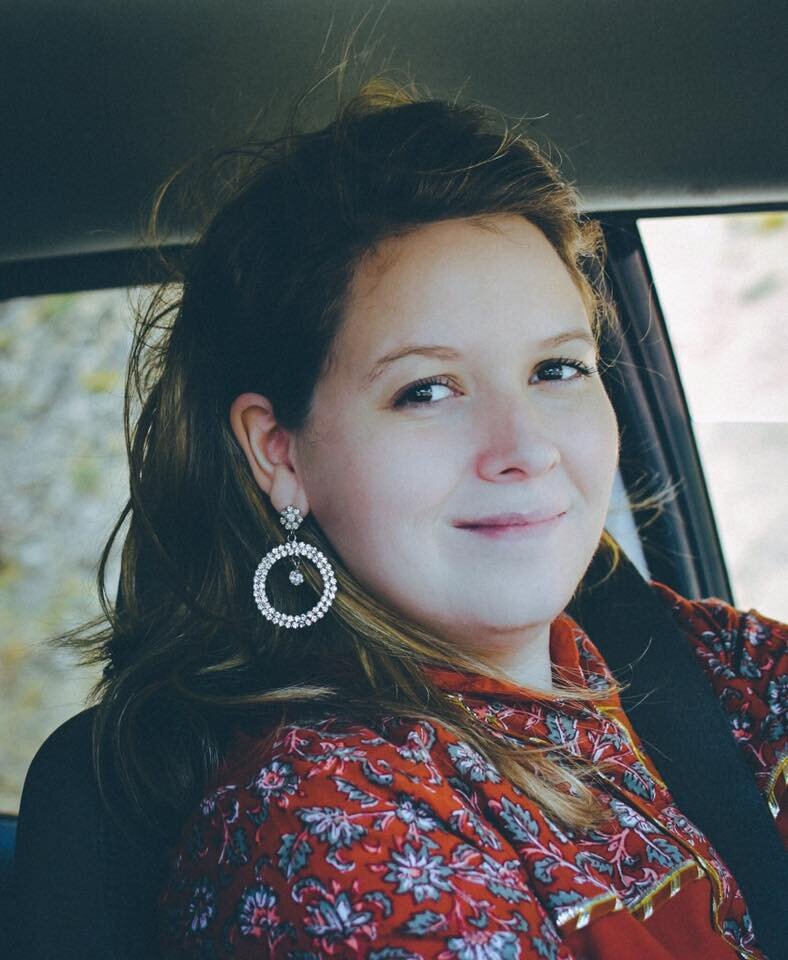 A few weeks ago, Molly, a fellow Almost Indian Wife shared what it's been like to move to India. She gave us a glimpse into her experiences and her struggles. Today, she's sharing more about her journey!
A few weeks ago, Molly, a fellow Almost Indian Wife shared what it's been like to move to India. She gave us a glimpse into her experiences and her struggles. Today, she's sharing more about her journey!
What has it been like for you to settle into a new country, new home, and fully integrate yourself into Indian culture?
Personally, I have gone through a lot while living in this other culture/country. I’ve gone through happiness, depression, loneliness, and just about every feeling.I used to be a VERY independent person, I mean I did everything; the chores, the errands, shopping, grocery shopping you name it! But ever since coming to India, I have to depend on my husband Jim for EVERYTHING! And he’s so busy with the ministry, sometimes I don’t get to go out of the house for weeks at a time! Which of course put a strain on our marriage in the beginning. I want to learn how to drive, so I don’t need to depend on Jim so much, but Jim doesn’t want me to learn because he himself is so scared of driving.The driving in India is the worst! Just imagine no one following any traffic rules, that’s how it is. The driving is also on the left side, with the steering wheel on the right, which is something I will have to learn. You can look up on YouTube, “driving in India” to see what it’s like.Either way, going outside as a “white” girl is the worst experience. I’m talking about the actual Indian experience, like shopping on the street corners, and getting expensive things for really cheap. Even walking on the streets is dangerous, you are surrounded by beggars and little kids that come up to you for money. I was even chased for 5 minutes one time because a lady wanted more money than what I gave her!
Common things you will see on the road:
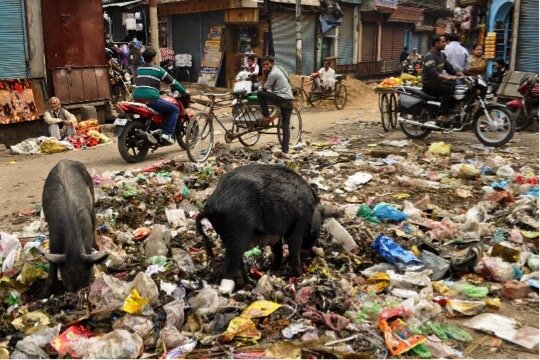
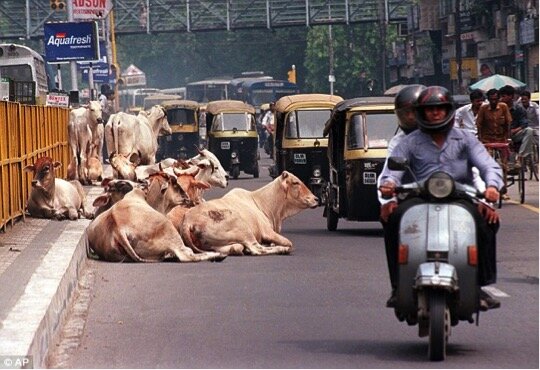 Also, because I'm White, Indians try their hardest to cheat and take advantage of me. When you shop on the streets, most of the time you can bargain with the salesman to get a better price, but with a white person...! They double and triple the cost of things!I can never go shopping without my sister in law because she knows the value of things and what the real cost is. They do have huge malls, and really nice stores where we live, and because of me, that is where we shop now. Jim’s family soon realized that they can’t take me shopping where they usually go because then they won’t get good prices.I just hate the thought of “bargaining” or “bribing.” It is something I am definitely not good at. So, just like America, we go to the more “fancier” shops where things have price tags on them. I always have to hide when there are vendors coming to the door, such as people selling clothes, bangles, jewelry because they will raise the prices.Even getting into an auto rickshaw I always have to stand behind Jim without them seeing me, then once he gets the cost of how much it will be, then I come around the corner and get in. I wish it wasn’t like that, but we certainly can’t afford triple the cost of everything just because of my skin color.I was definitely not prepared when we first moved to India. I just came from a place where you are friendly to people, can trust them to a certain extent, have your own privacy, people say their "please" and "thank you’s" etc. But here! It all went out the window. And since we came here for the ministry, there are certain things I should and shouldn’t do anymore. I can’t wear short sleeve shirts, no shorts, only full-length skirts, no tank tops, my arms have to be covered, I have to wear a shawl wherever I go, I can’t sit cross-legged in front of elders and my hair has to be covered in any church event.The clothing I have to wear is a chudidars or a sari (I can wear jeans only if Jim and I are going out, which isn’t very often). Also in church, the woman sits on one side while the men sit on the other.Indians are also very concerned about education. We have parents in our church who break their backs day and night as hard working laborers, just so that their child will get a good education. Education is everything to them, without it you're basically no one in society. Also, if their child has a chance to go abroad, it is a huge pride for the parents. I love hearing parents talk about their children who have gone to America because they seem to understand me more and the culture where I come from.In the end, my husband and I are here for God and the ministry. I have my moments of being homesick, there are good days and bad days. India is full of culture and diversity and I’m very blessed to be going through this experience. God has revealed a lot to me about myself and in our marriage. I feel that ever since living here, I’m able to understand Jim more because I’m living what he has lived his whole life before he met me and it has been tough but well worth the eye opener. We both love our cultures and that is one blessing our kids will have, a life of two very different worlds.
Also, because I'm White, Indians try their hardest to cheat and take advantage of me. When you shop on the streets, most of the time you can bargain with the salesman to get a better price, but with a white person...! They double and triple the cost of things!I can never go shopping without my sister in law because she knows the value of things and what the real cost is. They do have huge malls, and really nice stores where we live, and because of me, that is where we shop now. Jim’s family soon realized that they can’t take me shopping where they usually go because then they won’t get good prices.I just hate the thought of “bargaining” or “bribing.” It is something I am definitely not good at. So, just like America, we go to the more “fancier” shops where things have price tags on them. I always have to hide when there are vendors coming to the door, such as people selling clothes, bangles, jewelry because they will raise the prices.Even getting into an auto rickshaw I always have to stand behind Jim without them seeing me, then once he gets the cost of how much it will be, then I come around the corner and get in. I wish it wasn’t like that, but we certainly can’t afford triple the cost of everything just because of my skin color.I was definitely not prepared when we first moved to India. I just came from a place where you are friendly to people, can trust them to a certain extent, have your own privacy, people say their "please" and "thank you’s" etc. But here! It all went out the window. And since we came here for the ministry, there are certain things I should and shouldn’t do anymore. I can’t wear short sleeve shirts, no shorts, only full-length skirts, no tank tops, my arms have to be covered, I have to wear a shawl wherever I go, I can’t sit cross-legged in front of elders and my hair has to be covered in any church event.The clothing I have to wear is a chudidars or a sari (I can wear jeans only if Jim and I are going out, which isn’t very often). Also in church, the woman sits on one side while the men sit on the other.Indians are also very concerned about education. We have parents in our church who break their backs day and night as hard working laborers, just so that their child will get a good education. Education is everything to them, without it you're basically no one in society. Also, if their child has a chance to go abroad, it is a huge pride for the parents. I love hearing parents talk about their children who have gone to America because they seem to understand me more and the culture where I come from.In the end, my husband and I are here for God and the ministry. I have my moments of being homesick, there are good days and bad days. India is full of culture and diversity and I’m very blessed to be going through this experience. God has revealed a lot to me about myself and in our marriage. I feel that ever since living here, I’m able to understand Jim more because I’m living what he has lived his whole life before he met me and it has been tough but well worth the eye opener. We both love our cultures and that is one blessing our kids will have, a life of two very different worlds.
Do you have questions for Molly about her experiences? Ask her in the comment section!

My Multicultural Family: A Letter To My 5 Year Old
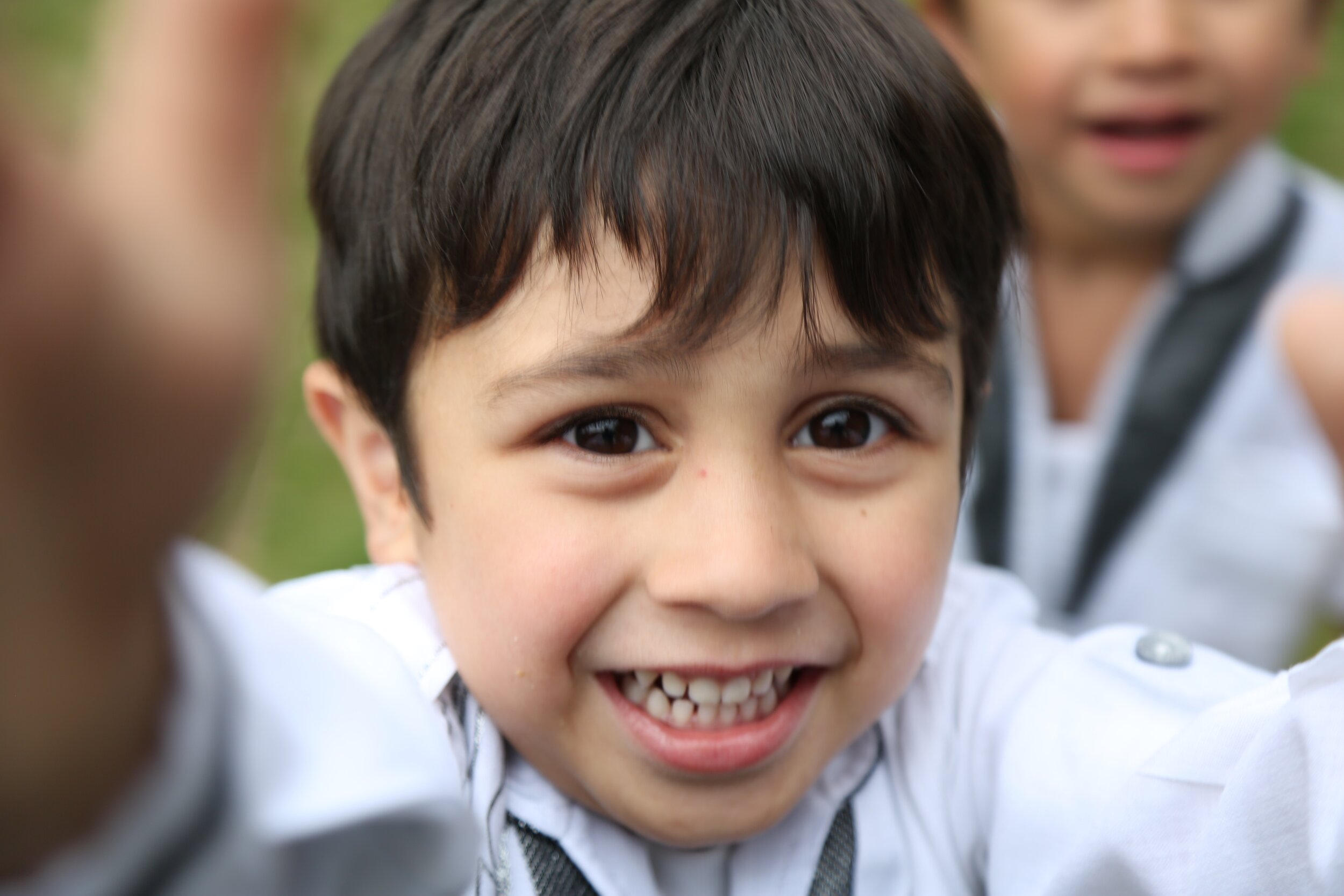
Dear Baby Boy,
Today is the day you've been counting down for. You're 5! You're 5 years old! My little baby is 5 whole years old. Even though you're so excited to be one year older today, momma wishes I could slow it down a little more.
Every night while we're praying, I pray God will make you stay my little boy forever and ever. You stop me every time and remind me God won't listen, with your little frantic voice. You want to be big so bad. You want to skip it all and be a big kid.
I hate to break it to you Baby Boy, but you will always be my little baby in my eyes. Even as you get bigger and don't need to depend on your momma as just as much. I'll always see you as the little baby that changed my entire life. I waited my entire life to be able to hold you in my arms.
You made my little world so much bigger.
You showed me what it means to love someone so much it hurts.
You taught me to see the best in everyone like you do.
You showed me what it means to be a loving unna (big brother).
Baby Boy you are teaching all of us more than you know. Your little brothers look up to you and I do too. You have such an innocent little heart and remind me every day to love people more. You love everyone around you and would do anything for them.
I can't wait to see the young man you grow into. You're going to be a world changer. All you have to do is be you because you are enough. You are such a blessing to everyone around you.
xo Momma
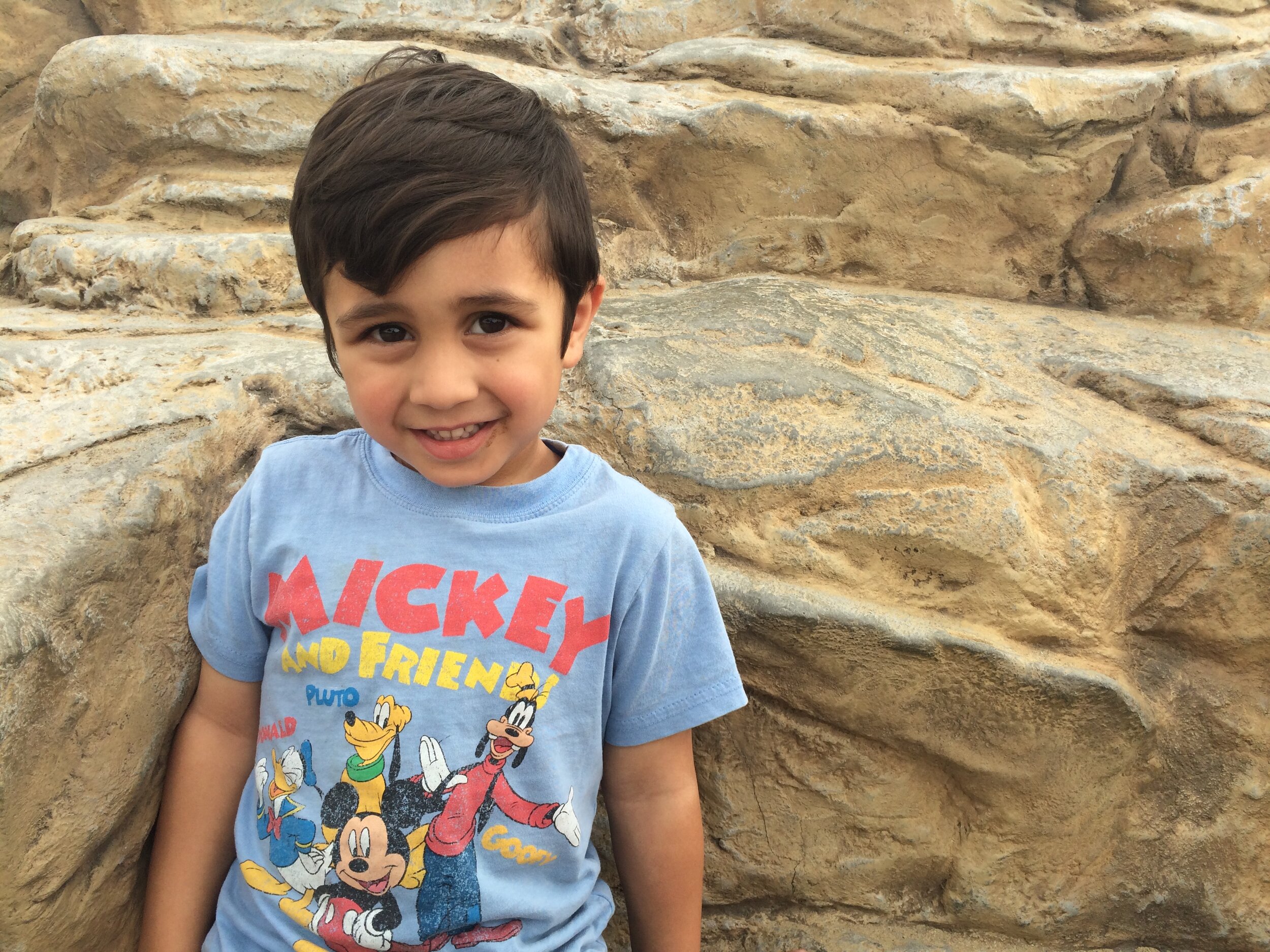
I was recently inspired by another blogger over at Baby Making Machine about the importance of making memories. She interviewed her little girl on her 6th birthday to remember it all and I'm doing that today too!
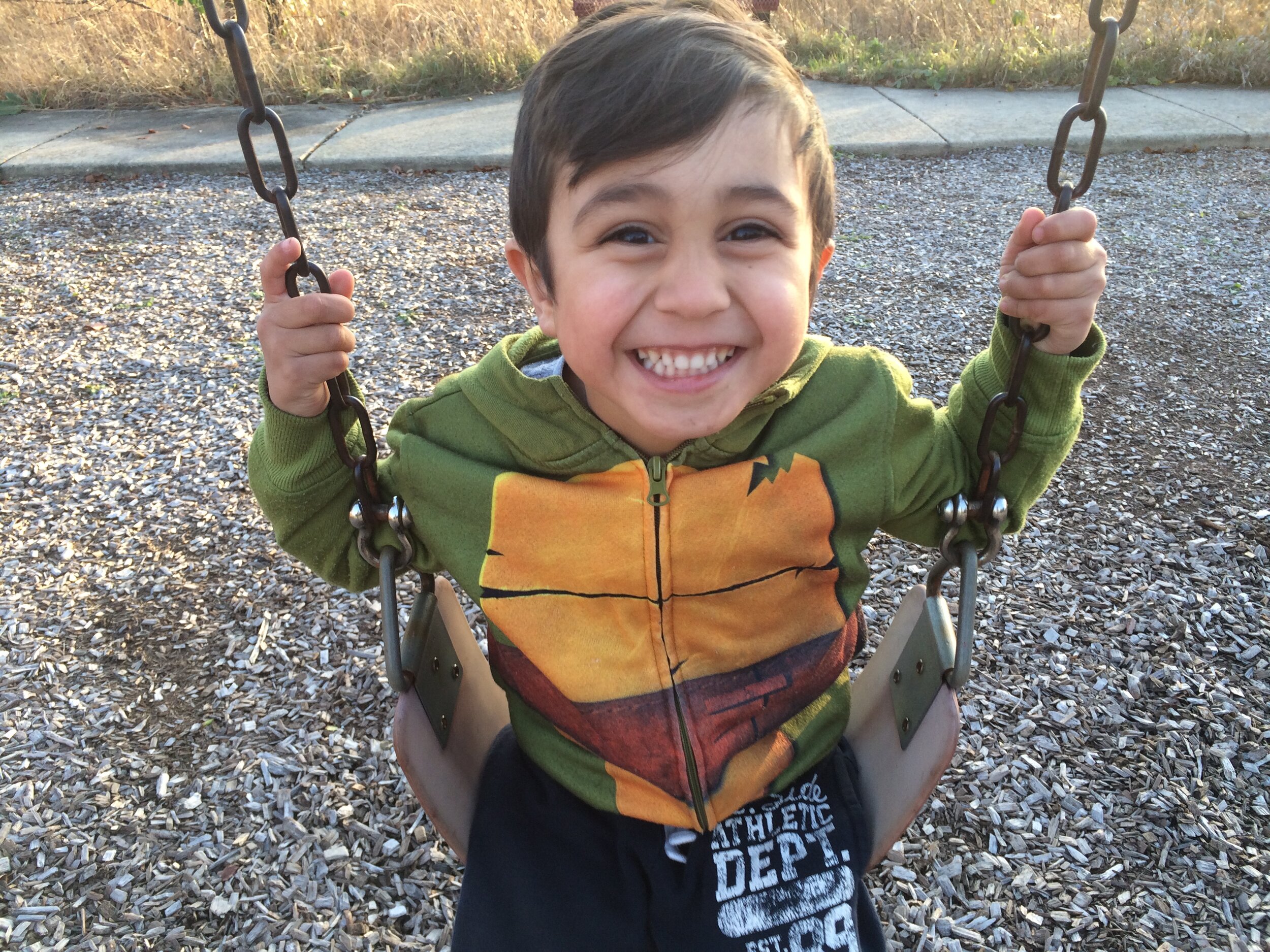 5 Year Old Birthday Interview
5 Year Old Birthday Interview
What's your favorite color? BlueWhat's your favorite food? Mac N CheeseWhat's your favorite thing to do? Camping OutWho's your favorite superhero? ThorWhat do you want to be when you grow up? A Grown UpHow many kids do you want to have when you grow up? ThreeWhat do you think makes someone a good daddy?Being nice.What kind of daddy are you going to be? Just like my daddy.
Meet Molly, A Fellow Almost Indian Wife
Today I am very excited to introduce you all to my friend Molly. She’s a fellow Almost Indian Wife and just got back after living in India with her husband. She took some time to share about her experiences in a new culture with all of us!
Molly tell us a little about yourself.
Hello everyone, my name is Molly Elliot and I’m married to my wonderful husband of 4 years, Jim Elliot. Jim and I were married in India, November 2012, and soon after that we came back to the U.S to work and save some money. We just came back to Bangalore, India January 2015 and have lived here ever since.These are pictures of our wedding.
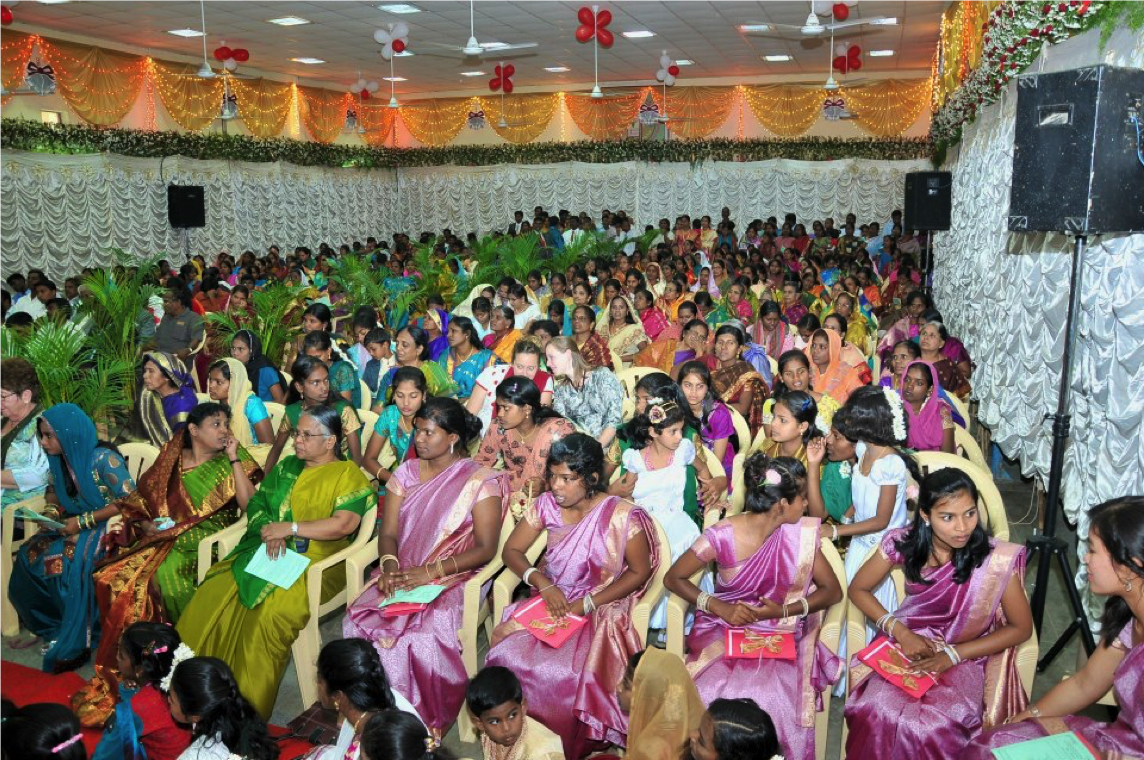
What was it like for you living in India? Can you share a bit about your experiences?
My experiences while living here in India have been both good and bad. I understand each state has their own culture, but I’ll share my experiences living with a Tamil family. My husband and I came here to do ministry alongside Jim’s dad who is a pastor, as well as help raise 11 street children (girls) that they have been running since 2001. We currently live with the girls, my in-laws, and Jim’s two sisters. The boys home (15 boys) is separate from the girls’ home, outside city limits.We live in a three floor house, the ground floor is my in-laws space, first floor is our space, and the second floor is the girls space.

What struggles have you faced while living in a new culture and home across the world?
One of the biggest struggles for me since we’ve moved here is not having our own place. In America, Jim and I lived on our own for two years, we learned how to survive with each other. Here in India, the son has the responsibility of taking care of his parents until their death. This was a huge strain on our marriage because I wanted it to be like America; live in our own house with our own rules, our own privacy, go to the in laws house if not every day then every other day. I wanted our life to be exactly the same as it was, but I learned the hard way that it would never be the same. Usually our day begins with being woke up by our wonderful neighbor who sweeps the outside of his gate at 3:30 in the morning for an hour, right outside our window. That’s one common thing you will see, all the women get up early to sweep the outside because of all the dust, then (if they are Hindus) they will decorate the cement with chalk designs.Then we go downstairs, have our morning tea, you can NOT start your day without having chai tea! we have our Indian breakfast which is usually; Dosa with Chutney, Idli, or Puri, or my ABSOLUTE favorite; Masala Dosa. Breakfast is my favorite meal of the day because it doesn’t involve rice.


Be sure to subscribe so you can catch part 2 of Molly's story! Do you have any questions for her?
Ask The Almost Indian Wife: How Can I Learn My Partner's Language
 Ask The Almost Indian Wife
Ask The Almost Indian Wife
This new series is here to help all of us discuss things we all deal with in our multicultural families. This week's question is important whether you are looking to learn your partner's language or if you want to raise your children in a bilingual household.
_________
Dear Almost Indian Wife,
"How do I, an English speaker, begin to learn my partner's language? Similar to Hindi, but it's actually Gujarati. In search of all resources, tips, and ideas to learn and to be able to communicate with only Gujarati speaking family members."
_________
How Can I Learn A New Language?
Learning a new language can be intimidating. Not to mention, feel impossible if it's not a common language in the US. I've wanted to learn Telugu since my husband and I got together, but it's been hard. I could never find resources to learn the language and ended up just learning words here and there.My determination was renewed when I had kids. I knew I wanted them to be fluent in both languages. My husband travels for a living and is gone a lot. I knew that meant I would be the one home with them the majority of the time so the responsibility would fall on my shoulders.I started researching every resource I could find. Here are the most effective ones I discovered.
Audio CD's
Go to your local library or look online for audio cd's. They tend to have more language options and work for any lifestyle. You can listen to them at home when the kids are napping, on the way to work or the gym, or at night after a long day.
Books
I wouldn't recommend a book as your sole method of learning, but it's a great supplemental resource. Once you learn the correct way to say the word, the book will remind you. Then you can read the book and it will teach you the correct way to put sentences together. If you're like me, your book will end up covered in highlighter!
Private Tutor
There are a ton of tutoring companies that offer different languages. Having a tutor come into your home or skyping with you is one of my top choices. They can hear you say different words or phrases and correct you. As you get to know the language better, you can even have conversations together.
Full Immersion
This is one of the most popular ways to learn a language. Whether you're trying to teach a child or learn later as an adult, this method work. Full immersion means you move to the country where the language is spoken or you move close to or into the same house as relatives that speak the language.This is what we aimed for with our children. We moved in with my father in law and he sits with our kids every morning and reads books to the in Telugu and teaches them different words. He also talks to them in Telugu. At first they had no idea what he was saying. Now, I've noticed them responding in English!
Tips For Learning A New Language
Learning a new language requires a lot of hard work and determination. If you're not careful, you will give up. It can start looking like more work than it's worth. Here are a few tips to help you.
Make It Fun
We are more willing to learn something new if we have fun doing it. Find different ways that you can enjoy learning it every day. One way to have fun is to learn with someone you love. If you're learning to be able with your spouse, practice with them. It's more fun to learn with someone.
Talk In The Language At Home
As you learn the language, start using it at home. Whether you use it for different words or complete phrases. You need to practice as much as you can. Even if that means you're home, talking to yourself. Practice, practice, practice.
Entertainment
Another way to make it fun is to bring your entertainment into it. Netflix has an entire foreign section! You can scroll through and look for a movie in the language you're learning. Then put subtitles on and enjoy! You will even start noticing how they put sentences together and pick up on what they're saying.
___________
The most important thing to remember when learning a new language is that it takes time. In a perfect world, we could learn overnight and start talking to family members in the language right away. In reality, it's going to take time and hard work.The great thing is that it's going to mean so much to your new family when they see you learning their language. They know you're learning so you can talk with them. As you learn, start using what you do know in conversations together. They can take part in helping you learn and it can become a bonding moment between you.
What tips or questions do you have about this week's topic?
How Should We Talk About Someone's Ethnic Background?

When Is It OK To Ask About Someone's Ethnic Background?
Curiosity is a normal part of human behavior. When we see something we aren't familiar with or can't label, we want to figure it out. As a mother of biracial children, I do tend to notice other biracial individuals and my mind starts to wonder. However, I wouldn't ask them about it unless we knew each other on some level.There are so many different views on this. Personally, I think you should get to know someone or at least know their name before you start asking questions about their ethnic background. As you start getting to know someone, it becomes a natural part of the process. You start asking each other questions and learning what makes each other tick.I love learning about someone's background because it all plays a part in who they are. Whether they grew up with a single mom, in Hyderabad, are the oldest in their family, etc. It's all a part of who they are.
What If I Don't Know How To Ask
People can usually tell if you're asking about their ethnicity because you care about them as a person or if you just want to fulfill your own curiosity. If they see you're being genuine, the how isn't usually a big deal. They can see that you aren't trying to be rude and that you are asking the best way you can. Then they're usually more willing to answer you.The problem is when people start throwing in stereotypes and assuming things about a complete stranger.
Here's What You Shouldn't Say To Someone Of A Different Ethnic Background Than Yourself
I asked my readers to share some common misconceptions they've experienced. Here are a few of the ones that really make you wonder what the stranger was thinking!
"I'm giving you the Hindi pamphlet so you can understand."
It doesn't matter whether or not you actually needed the pamphlet in a different language. They assume you do because you're Indian.
"His family must be really upset that you're married. Do they hate you?"
How do they know how your relationship is with your in laws? They assume there's strife because he's Indian and you're not.
"Was it really hard growing up in the US?"
They must be forgetting that the United States is full of people with different ethnic backgrounds. Just because you see an Indian man doesn't mean they grew up in India or a Russian women mean she grew up in Russia.
"You're so light! There's no way you can be African American!"
Who made the decision that you have to be a certain shade to "qualify" as African American?
Here's What You Should Do If Your Curious About Other Ethnic Backgrounds
As a society, we should all be learning about different cultures. The more we learn about them, the less likely we are to make generalized stereotypes. Stereotypes are what causes issues in talking about someone's ethnic background. Instead of asking someone about their background, we make statements based on what we assume to be true. Instead of assuming, learn.You should ask someone about their ethnic background to learn more about them as a person and to learn about their culture. Sometimes, it's hard to identify stereotypes we may have. The more you learn about another culture, the more those stereotypes are broken.
Let's Keep The Conversation Going
This has become a sensitive topic in our society. People get too nervous of saying the wrong thing and end up not talking about ethnicity at all. We need to challenge this and get the conversation going. The more we talk about race and ethnicity, the more walls are broken down.I want my kids to grow up in a society where they can be proud of their ethnic background and not feel ostracized for it. They love being biracial because they get to see amazing things from their culture. This can stay the same if we let all the stereotypes go and break down barriers between each other.
Pin For Later
3 Things Muhammad Ali Taught Our Children
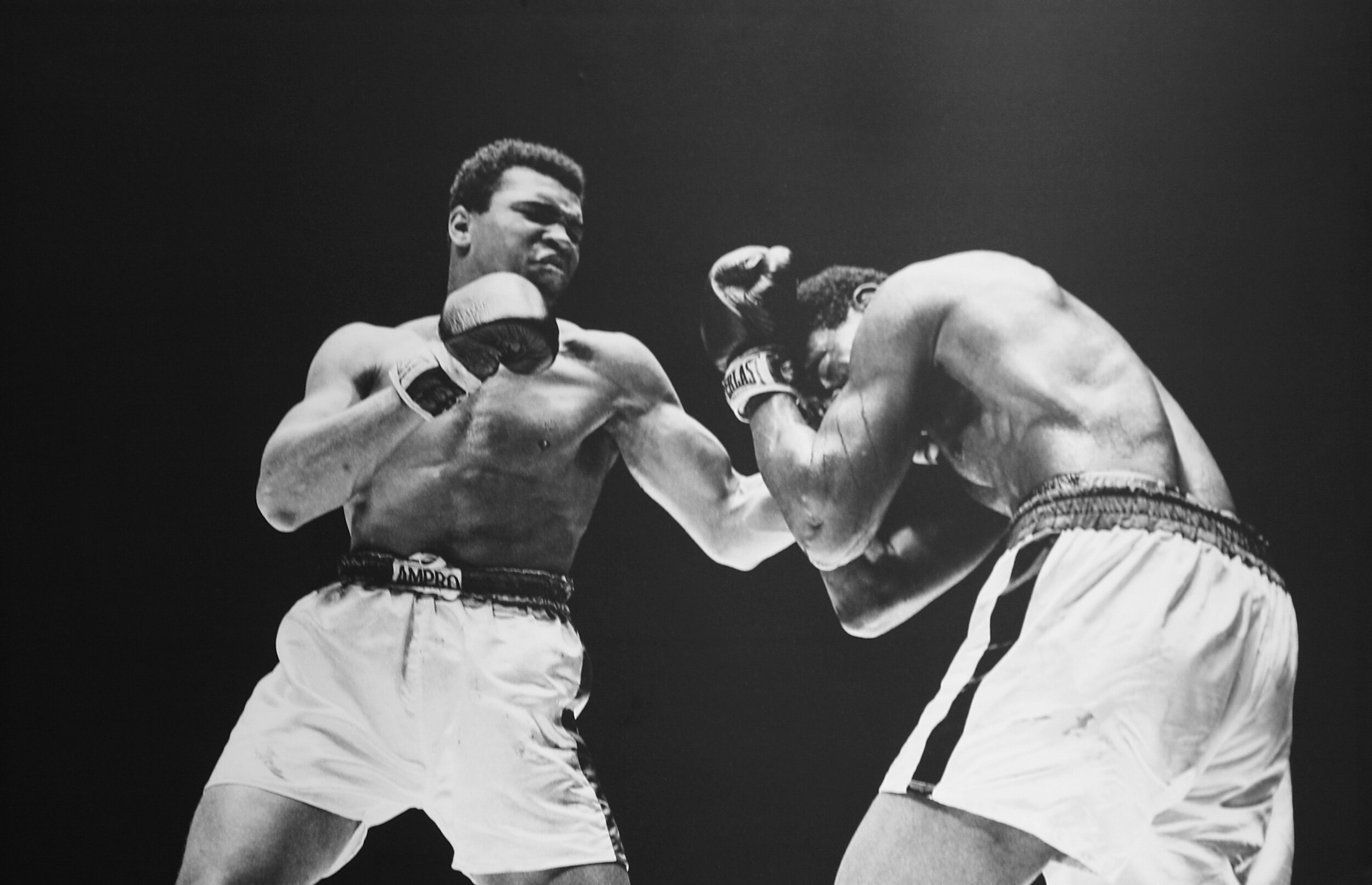 We lost one of the greatest heroes in history yesterday. Muhhamad Ali died at the age of 74 from complications due to Parkinson's Disease. When you think of this influential man, you think boxing champion. He won 56 fights through out his time as a heavyweight boxer.Did you know he also risked everything he loved to stand against injustice?
We lost one of the greatest heroes in history yesterday. Muhhamad Ali died at the age of 74 from complications due to Parkinson's Disease. When you think of this influential man, you think boxing champion. He won 56 fights through out his time as a heavyweight boxer.Did you know he also risked everything he loved to stand against injustice?
3 Things Muhammad Ali Taught Our Children
You can do anything you set your mind to.
Muhammad Ali was born in a time of servanthood in Louisville, Kentucky. While slavery had ended over one hundred years prior, racial castes still existed. At the time, the most Muhammad Ali could have strived for was to be a teacher in an all black school.As a young child Muhammad Ali knew where he stood in society. While he was with his father, he asked a store clerk for a drink of water. He was extremely thirtsy and instead of getting a simple drink, was called the "n" word. He encountered many similar occasions through out his life, but at the age of 12 years old, he had enough.His bike was stolen and he was devastated. As he was crying, he found a white police officer, Joe Martin and told him he would beat up the people that took his bike. Joe Martin was impressed with him and told he that he would have to learn how to fight first. This was the beginning of his boxing career.He didn't follow the path that society had set before him. He decided to do something different and that he loved. Little did he know the impact his boxing would have on decades to come.
Fight for what you believe in.
In the 60's Muhammad Ali had started voicing his strong opinions about racial injustice. At that time, The Vietnam War was raging on. Most men were being drafted and going to fight against Vietnam. When Muhammad Ali was drafted, he said no. This was unheard of. Fighting for your country wasn't a choice, it was duty. You did it because your country asked you to.
"Why should they ask me to put on a uniform and go ten thousand miles from home and drop bombs and bullets on brown people in Vietnam while so-called negro people in Louisville are being treated like dogs and denied simple human rights."
Muhammad Ali
Muhammad Ali refused to fight for freedom across the globe when black citizens weren't being offered the same rights. In response, he was convicted of draft evasion and sentenced to five years in prison. He didn't end up serving that time in the end, but he didn't know what would happen.
Muhammad Ali stood up against injustice, risking it all. He ended up being exiled from the boxing world. He wasn't only the "wrong race" now, but he was also someone refusing to fight for his country.
He ended up becoming the talk of the town. Everyone was talking about him and his refusal to fight in Vietnam. White and black citizens started to stand up with Muhammad Ali and fought injustice.
Whether or not you agree with his decision about Vietnam, he fought for what he believed in. He thought it was wrong to fight for freedom somewhere else, when black US citizens didn't even have that same freedom.
You can make a difference.
Muhammad Ali fought through his boxing exile and made a name for himself. He never gave up on his dream. He knew it was worth fighting for and had the support of so many people, fighting in his corner.He knew his refusal to fight in Vietnam would have consequences, but he did anyway.He knew society didn't want a black boxer, but he did it anyway.He never let society tell him what he had to do. He stood up for what he believed was right and he made a lasting impression on our nation. He broke the mold society made and taught generations of people, that they can do anything.By teaching our children about Muhammad Ali's life, they can see how strength and determination matter. They can see how hard he fought against injustice and because of that racial castes were broken.When he boxing career ended, he later developed Parkinson's disease. As the world changer that he was, he used his platform to spread awareness for the disease. He never let anyone or anything silence him.Even though his boxing career ended, his fight never did.
Today, let's celebrate Muhammad Ali and the impact he had, not only on my family, but yours.
Pin For Later

Multicultural Round Up #2: Top Posts For Multicultural Families
This week's Multicultural Round Up is full of great posts from moms around the blogosphere. They're all sharing about their multicultural families and I know you'll love them as much as I do!
Top Posts For Multicultural Families
 Image Credit: Vanessa from De Su Mama
Image Credit: Vanessa from De Su Mama
6 Myths Of Interracial Marriages According To A Latina Wife
Vanessa from De Su Mama does an amazing job at identifying some of the common things people think about interracial marriages. One of the myths that stood out to me the most was #6 All Interracial Relationships Are The Same. Every relationship is different because we as couples are different. It's important to understand how different our relationships are so we don't start comparing them to each other.
 Image Credit: Stacy-Ann from Weather Anchor Mama
Image Credit: Stacy-Ann from Weather Anchor Mama
What You Should Know About Raising Biracial Children
I love this post by Stacy-Ann from Weather Anchor Mama. She talks about some of the key things multicultural families need to know, want to know, or are asking. She even has a great video at the end on some secret tips from her and her husband!
 Image Credit: Mari from We Are That Familia
Image Credit: Mari from We Are That Familia
Parenting Biracial Children: 6 Tips From Moms Who Have Been There
This post is seriously amazing! It's a list of tips from moms with multicultural families. They all share advice and wisdom they've gained from years of raising multicultural children and being in intercultural relationships.
 Image Credit: Ellie From Musing Momma
Image Credit: Ellie From Musing Momma
Dealing with Questions & Curiosity as Parent in a Mixed Race Family
Ellie from Musing Momma has been one of my favorites for a while now. She is a psychologist and a mom with a multicultural family. The advice she gives is amazing and practical. This post is all about questions parents of multicultural children get and how to respond.
 Image Credit: David Martinez, Renee Loiz
Image Credit: David Martinez, Renee Loiz
16 Easy Ways To Raise A Bilingual Child
Pam does a great job over at Parents in giving us advice on how to raise bilingual children. Many multicultural families struggle to teach their children multiple languages because it can seem overwhelming. This post is full of fun and simple ideas!
Which one was your favorite multicultural post?
AIW Tribe Mother's Day Gift Guide
Mother's Day is almost here! A day entirely devoted to the woman that took care of you, selflessly your whole life. They spend all of their time and energy on you, making sure you're happy and taken care of. You have one day a year to completely obsess over them and thank them for everything. Check out the AIW Tribe Mother's Day Gift Guide and pick one or a few gifts to spoil them with!
 Funny Gifts:
Funny Gifts:
- "I Love How We All Know I'm Your Favorite Child" Coffee Mug
- "What I Love About Mom" Fill In The Blank Book
- "Mama Saur" Shirt
- "Go Away" Coffee Mug
Spoil Her Gifts:
- Mother's Day Coloring Book
- Bath Bomb Set
- Ghirardelli Chocolate Basket
- Family Tree Frame
- Burt's Bees Set
- Scarf
 Best Kid Ever Gifts
Best Kid Ever Gifts
5 Steps For An Intercultural Relationship

5 Steps For YOUR Intercultural Relationship

Get To Know Each Other
If you want to figure out how to blend cultures and start your family together, you need to know each other. Take time to get to know who you're together with. I don't just mean their favorite color and what they like to watch on tv.You need to understand their culture. Their culture has shaped who they are and the decisions they'll instinctively make. Ask them questions about how they grew up, what they value from their culture, what they've struggled with in their culture, etc. All of this will help you to understand each other.
Develop A Family Culture
Now, it's time to develop a family culture. When you and your loved one start your relationship, you're starting a family. It doesn't matter if you have kids or not, you're a family. When you start a family, you have to develop your own family culture and identity.The best part is this culture will be from both of you. You need to sit down and talk about what's important from both of your cultures and decide how you can bring them together in one family. The best part is you don't have to worry about making the absolute best plan ever!While making a plan is vital, you can change it up when you need to. The idea behind the plan is to know before hand what's important and you can be more intentional in bringing it into your family.
Communicate
The lines of communication need to be open at all times. As you get to know each other, you'll feel more comfortable talking and discussing how your relationship is doing. Conflict is natural and will come up through your relationship. It will come up when trying to figure out how to blend cultures, when dealing with culture shock, and pretty much any time during your relationship. It's normal.The most important thing is that you learn how to communicate with each other so you can learn how to use your conflict to get closer.You also need to be able to discuss how you feel about blending cultures. Are you comfortable with how the blending is happening? Do you feel like one culture is taking over? These are important things you need to talk about through out your relationship.
Re-evaluate
While the plan you develop may work great right now, you need to be prepared that it will change. You and your loved one have to constantly re-evaluate how your plan is working. If it's not working like you thought or you'd like something to change, tweak it.It's going to change naturally over time because the longer you're together, you'll notice you're both changing. You're growing together and getting closer and your circumstances may change as well.You should be scheduling time to talk about all of these things at least once a month.
Give Each Other Grace
Grace. Your relationship needs to be filled with grace. You are bound to mess up or hurt your loved one's feelings and the other way around. The biggest thing is to remember you need to give each other grace. Blending cultures takes time. Even if you're been together for years, you aren't mind readers and things just happen.All you can do is be sure to talk about it, let them know how you feel, and give each other grace. Let your loved one know they have room to mess up and you'll still love them.--Intercultural relationships are beautiful, but they take a lot of patience and grace for each other. I can promise you one thing, it's always worth it. The more you and your loved one work at your relationship, the better it will be.
How Can We Teach Kids To Celebrate Diversity
As a multicultural family, we're always looking for ways to teach our children about diversity. In a society that teaches our kids to blend in and avoid standing out, it's our responsibility to teach them to have pride in their differences. It's important for us to teach them that those differences make up who they are.In celebrating those differences, we surround our kids with diversity. We want diversity to become the norm for them. There are so many different ways you can teach your kids about diversity.

3 Fun Ways To Teach Your Child About Diversity
Games
Teaching your child through hands on activities is a great way to get the conversation going about diversity. You can play world games or you can look up games played in other countries. By making it fun, you've already grabbed their attention and their more likely to stay engaged because they want to learn more.
School
As our kids get older, they're in school about 3-8 hours a day. It's most of their day! Schools are the perfect opportunity to talk with your children about diversity. If your kid's schools don't offer programs that encourage diversity, start one! Start a multicultural festival where kids hear about different cultures around the world! Get involved and make diversity happen in your kid's schools. Your kids will love it!
Books
Books are one of our favorite ways to talk to our kids about diversity. It not only gets your kids excited to hear about the story, but it creates dialogue. Your kids will want to learn more about the pictures in their books. They want to know all about the characters, what makes them who they are, and how they can relate to them. 
Where Do I Find Books Featuring Multicultural Kids And Families
Finding books about multicultural kids is hard. If you do find it, a white child is usually the main character. It has been a huge challenge for me to find books with a non-white child as the main character. I have great news... I found it!Bharat Babies is a wonderful company that features Indian children as the main characters in all of their books. Their books teach children about India through beautiful stories. As your child reads a book like Let's Celebrate Diwali, they will learn why children in India celebrate the holiday and meet Harini and her friends. 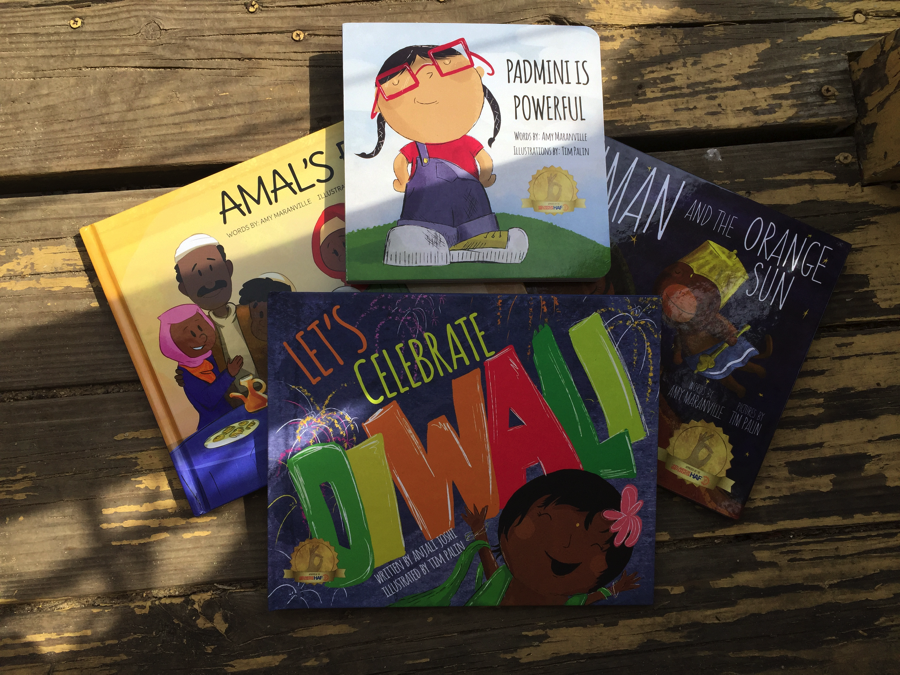 Bharat Babies books are great for children whether they live in a multicultural family or want to learn about a different culture. As parents, it's our job to teach our children about diversity. It needs to be a conversation so kids can ask questions and understand the differences that make us up are beautiful. I love how Bharat Babies celebrates diversity in their books!Let's join together and teach our kids about diversity today!
Bharat Babies books are great for children whether they live in a multicultural family or want to learn about a different culture. As parents, it's our job to teach our children about diversity. It needs to be a conversation so kids can ask questions and understand the differences that make us up are beautiful. I love how Bharat Babies celebrates diversity in their books!Let's join together and teach our kids about diversity today!
Learn more about Bharat Babies and stay up to date on new books by following themFacebook/ Twitter/ Instagram/ Blog
***This post was sponsored by Bharat Babies. As always all opinions are my own.**
Multicultural Finds #1
 This Week's Multicultural Finds
This Week's Multicultural Finds
1. Board Book | Karen Katz 2. In Her Kitchen Cookbook | Gabriele Galimberti 3. Yoga Burn Out Tank Top | Tough Cookies4. Lego World People | Lego 5. Multicultural Crayons | Crayola 6. Brainbox Around The World Game | Mind Ware
*I do receive a small commission from any products purchased, but as always I only recommend items I actually love*
How Can Schools Embrace Diversity

How Can Schools Embrace Diversity
Focus On All Major Holidays
During Holi (an holiday celebrated in India), my Facebook feed went crazy! My friends in India and the US were celebrating. Colleges in the US were even celebrating the colorful holiday by taking the colored powder to the lawn and having a great time! However, the one place I didn't see students celebrating or even talking about it was in elementary schools. They missed a huge opportunity to teach kids about India. Schools say they don't celebrate most holidays because of the religious ties to them. Just because you talk to your students about a holiday in India doesn't mean you need to convert them to hinduism while you're at it. By teaching students about major holidays celebrated around the world, you make students from those countries feel accepted and normal. You're also opening up your student and teacher's minds about something different to them.
Ask Questions Instead Of Avoiding Situations
I recently heard about a school where the principle will avoid saying international student's last names. During an assembly, he will list off first and last names until he gets to them and then he just uses their first name... Do you think that student feels normal or accepted when their own principle is too embarrassed to try and say their last name? No. All he had to do is get to know his students and ask them. By asking how to say their last name correctly, the student can see that the principle cares. Often times, teachers and adults will avoid topics because they're embarrassed. It only leads to students feeling ostracized and abnormal. Instead, they should be facing those situations head on and educate themselves.
Teacher Trainings
Teachers need to be educated on their students. They need to understand who they are, where they came from, and general religious practices. These trainings are the perfect time for teachers to ask their questions without a fear of saying the wrong thing. As teachers become more comfortable with different cultures, their teaching style will change. You need to know your students to know how you can teach them and how to really speak into their lives. --We need to bridge the cultures gap at home and in our schools. Diversity needs to be what's normal for our children, rather than teaching them to avoid talking about what makes us different.



